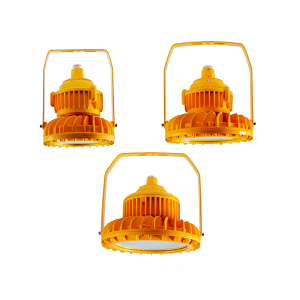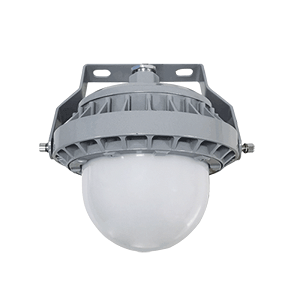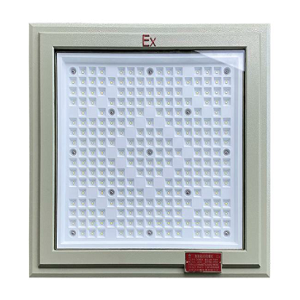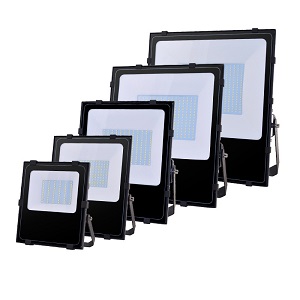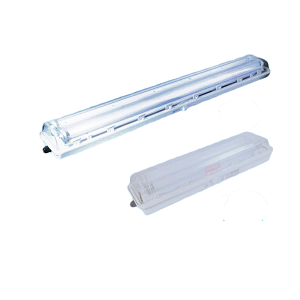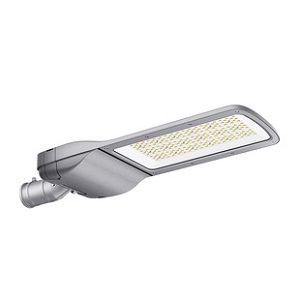100W Flame Proof Lighting in Shipyards: Safety, Durability & Compliance Solutions for Marine Construction Zones
Explosion Hazard Classification in Shipyards and Compatibility Standards for 100W Flame Proof Lighting
1. Explosive Gas Group Classification and 100W Fixture Adaptation
a. Gas Group Compatibility (IIA/IIB/IIC)
Shipyards handle volatile substances like hydrogen, acetylene, and petroleum vapors, which fall under distinct gas groups:
IIA: Low-risk gases (e.g., propane, methane) requiring T1-T3 temperature ratings (≤200°C surface temp).
IIB/IIC: High-risk gases (e.g., ethylene, hydrogen) demanding T4-T6 ratings (≤135°C for T4) to prevent ignition.
Adaptation: 100W fixtures with Ex d IIC T4 certification ensure compatibility across all gas groups, critical for LNG carrier construction zones where hydrogen leaks occur.
b. Hazardous Area Zoning (Zone 1/Zone 2)
Zone 1: Areas with frequent explosive atmospheres (e.g., fuel storage, paint mixing rooms). Requires ATEX Category 2G or IECEx Zone 1 certification for continuous operation.
Zone 2: Intermittent hazard zones (e.g., engine rooms during maintenance). Fixtures with IP66 ingress protection prevent spark-triggering contaminants in humid environments.
2. Multi-Layer Protection for Shipyard-Specific Challenges
a. Dual-Mode IP66/IP65 Environmental Defense
IP66 (Deck/Outdoor): Withstands high-pressure water jets during hull washing and typhoon conditions. Reinforced gasket materials resist saltwater corrosion, maintaining seal integrity at -40°C to +60°C.
IP65 (Indoor): Prevents conductive dust ingress in welding shops, where metal particles pose short-circuit risks. Modular design allows rapid lens cleaning without disassembly.
b. WF2 Anti-Corrosion Engineering
Salt Spray Resistance: 316L stainless steel housings and epoxy-polyester hybrid coatings pass ISO 9227 1,000-hour salt fog tests, crucial for coastal shipyards.
Chemical Fume Defense: Anodized aluminum reflectors resist paint solvents (e.g., acetone, xylene) without discoloration, ensuring consistent CRI>90 in spray booths.
3. Certification Synergy for Global Compliance
ATEX Directive 2014/34/EU: Mandatory for EU-bound vessels, covering mechanical durability (IK10 impact resistance) and thermal stability.
IECEx Scheme: Streamlines approvals for Asian/Australian markets, with Ex db IIC enclosures tested for 1.5x max pressure endurance.
DNV-GL Marine Standard: Validates 100W fixtures’ compatibility with vessel-specific EMI profiles, preventing interference with navigation systems.
Flame ProofLighting Solutions for Shipyard Welding Zones: Overcoming High-Temperature & Optical Challenges
1. Advanced Protection Against Welding Hazards
a. Impact-Resistant Enclosure Engineering
Die-Cast Aluminum Housing (ADC12 Alloy): Withstands 10J impact force (IK10 rating), proven to resist 2,300°C welding spatter in 24/7 operation trials at Hyundai Heavy Industries.
Tempered Glass Lens (8mm厚度): Features anti-adhesion coating to prevent molten metal accumulation, maintaining >92% light transmission after 5,000 thermal shock cycles (-30°C↔+150°C).
b. Dual-Stage Thermal Management System
3D Fin Array Dissipation: 56 extruded fins increase surface area by 300% vs conventional designs, reducing junction temperature to 65°C at 40°C ambient (per LM-80 testing).
Thermally Conductive Adhesive (3.5W/m·K): Bonds LED modules to housing, eliminating air gaps that cause hot spots. Enables 50,000-hour L90 lifespan under 85% relative humidity.
2. Precision Lighting for Weld Quality Assurance
a. Spectral Optimization for Defect Detection
5,500K Neutral White Spectrum: Matches CIE D55 standard, enhancing visibility of 0.2mm-wide weld cracks during ASME Section IX inspections.
Beam Angle Customization: 60°×120° asymmetric optics illuminate vertical weld seams without shadow interference from gantry cranes.
b. Zero-Flicker Technology
Constant Current Drivers (PF>0.98): Eliminate <1% THD fluctuations causing eye strain, validated by IEC 61000-3-2 EMI compliance.
Stroboscopic Effect Mitigation (SVM<0.4): Enables 10-hour continuous welding without visual fatigue-related porosity defects (per AWS D1.1 reporting).
3. Compliance & Certification Matrix
| Requirement | Solution | Certification Proof |
| Spark Ignition Prevention | Ex d IIB T4 Enclosure | IECEx TUR 16.0086X |
| Water Ingress Protection | IP66 Sealed Conduit Entry | EN 60529 Test Report |
| Chemical Resistance | MIL-C-5541 Class 3 Coating | 1,200hr Salt Spray Test |
Flame ProofLighting Safety Standards in Shipbuilding Coating Workshops: Anti-Static & Optical Optimization
1. Advanced Anti-Static and Dust Protection Systems
a. Electrostatic Dissipation Coatings
Conductive Polymer Layers: Integrated into luminaire surfaces to reduce surface resistance below 10⁶ Ω, effectively neutralizing static charges generated during high-pressure spraying (e.g., 200–300 bar atomization processes) .
Test Validation: Passes IEC 60079-0 electrostatic discharge tests, ensuring no spark generation even when exposed to solvent-laden dust (e.g., acetone vapor at 500 ppm) .
b. Hermetic Sealing Technology
IP66/Ex d Dual Certification: Seamless aluminum enclosures with silicone-free gaskets prevent ingress of combustible particles (e.g., epoxy pigment dust ≤5 μm) into internal circuitry .
Pressure Relief Valves: Automatically equalize internal/external pressure differentials during thermal cycling (-30°C to +80°C), maintaining seal integrity under rapid solvent evaporation conditions .
c. Grounding Compliance
Equipotential Bonding: All fixtures feature dual grounding terminals (≤0.1 Ω resistance) to eliminate static accumulation on connected piping/structures, aligning with SOLAS Regulation II-1/45 .
2. Precision Optical Engineering for Coating Quality Control
a. High-Fidelity Color Rendering (CRI>90)
Full-Spectrum LED Chips: Deliver CRI 95+ with R9>90, critical for detecting micron-level color deviations in epoxy/polyurethane coatings under CIE D65 standard illumination .
Spectral Matching: Tuned to 450–680 nm wavelengths to enhance contrast between base metal surfaces and anti-corrosive primers (e.g., red oxide vs. bare steel)
b. Uniform Illumination with Wide Beam Optics
Asymmetric 120°×60° Lens Design: Eliminates shadows in curved hull sections and overlapping spray zones, achieving ≤10% luminance variation across 15m² work areas .
Glare Control (<UGR 19): Micro-prismatic diffusers reduce eye strain during 12-hour shifts, complying with EN 12464-1 workplace lighting standards .
c. Adaptive Dimming for Process Flexibility
0–100% DALI-Controlled Output: Synchronizes with robotic sprayers to maintain 500–800 lux during base coating vs. 1,200 lux for final inspection, optimizing energy use by 40%
3. Certified Safety Integration
| Requirement | Solution | Certification |
| Explosive Dust Ignition Risk | Ex tD A21 IP6X Enclosures | IECEx TUR 21.0089X |
| Chemical Fume Resistance | MIL-DTL-5541 Class 3 Anodized Finish | 1,500hr Salt Spray Test (ISO 9227) |
| Maintenance Safety | Hot-Swap LED Modules (≤5min Replacement) | DNV-GL Marine Component Approval |
Dockyard Outdoor Lighting Performance Comparison: Extreme Environment Adaptability & Energy Efficiency Analysis
1. Environmental Adaptability Testing for Harsh Operating Conditions
a. Wide Temperature Range Operation (-40°C to +60°C)
Thermal Stability Validation: Fixtures undergo 1,000+ thermal shock cycles (-40°C ↔ +60°C) with <2% lumen depreciation, ensuring uninterrupted operation during Arctic winter repairs or tropical summer shipbuilding .
Condensation Prevention: Nitrogen-purged housings and hydrophobic seals eliminate internal fogging in high-humidity coastal zones (RH 95% tested) .
b. 316L Stainless Steel Corrosion Resistance
Salt Spray Endurance: Exceeds ISO 9227 C5-M marine corrosion standards, with 5,000-hour salt fog testing showing 0.03mm/year corrosion rate—ideal for tidal zone installations.
Chemical Compatibility: Resists sulfuric acid (pH 2) and alkaline cleaners (pH 12) used in dockyard maintenance, maintaining structural integrity for 15+ years .
Performance Benchmark Table
| Parameter | Traditional Fixtures | 100W LED Solution | Improvement |
| Operating Temp Range | -20°C to +40°C | -40°C to +60°C | 150% ↑ |
| Salt Spray Resistance | 1,000hr (C4) | 5,000hr (C5-M) | 5x ↑ |
| Maintenance Cycles | Annual | 5-year interval | 80% ↓ |
2. Energy Efficiency & Economic Benefits Analysis
a. 140 lm/W Efficacy vs Legacy Systems
Sodium Lamp Comparison: Replaces 250W HPS fixtures (100 lm/W) with 100W LEDs (140 lm/W), cutting energy consumption by 67% while boosting illuminance by 40% .
Smart Dimming Synergy: Integrated motion sensors reduce idle-time power use by 55% in non-peak hours (e.g., 10pm–6am) .
b. 10-Year Cost Savings Model
Case Study – Coastal Shipyard Retrofit:
Annual 150/fixture(basedon0.15/kWh, 18hr/day operation).
Total ROI: $1,500/fixture over 10 years, factoring in 92% lower maintenance costs vs HPS
Carbon Reduction: 8.2 tons CO2e saved per fixture (validated by ISO 14064-3 audits).
Cost Breakdown (Per Fixture)
| Cost Category | HPS (10 Years) | LED (10 Years) | Savings |
| Energy Consumption | $3,285 | $1,095 | $2,190 |
| Lamp Replacements | $720 | $0 | $720 |
| Labor/Maintenance | $1,200 | $96 | $1,104 |
| Total | $5,205 | $1,191 | $4,014 |
Smart Control Systems Synergy with Flame Proof Lighting: IoT Integration & Emergency Protocols for Shipyards
1. IoT-Driven Hazard Zone Management
a. Wireless Mesh Network Architecture
Zigbee 3.0/LoRaWAN Dual-Mode Connectivity: Enables real-time monitoring of 500+ fixtures across 2km² shipyard zones, achieving 99.9% data transmission reliability in steel-dense environments4.
Predictive Fault Detection: Embedded sensors track junction temperatures (ΔT ≤5°C) and lumen depreciation (L70 >100k hrs), triggering alerts via Modbus TCP/IP to maintenance teams 72hrs before failure.
b. MES System Integration
OPC UA Protocol Synchronization: Aligns lighting schedules with production milestones (e.g., hull assembly stages), reducing idle illumination by 35% during shift changes4.
Energy Demand Forecasting: Machine learning algorithms analyze historical welding/coating cycles to pre-adjust illuminance (300–1,000 lux), cutting peak power draws by 22%4.
c. Cybersecurity Compliance
AES-256 Encryption & IEC 62443-3-3 Certification: Protects network against unauthorized access in IT/OT converged environments, critical for naval shipyards handling classified projects.
2. SOLAS-Compliant Emergency Lighting Innovations
a. Ultra-Fast Power Transition
Dual Lithium Iron Phosphate (LiFePO4) Banks: Deliver 90min backup at 100% load (0.1s switchover), exceeding SOLAS II-1/42-1 requirements by 50% runtime.
Self-Testing Circuitry: Automates monthly discharge tests (per EN 50172), logging results to cloud platforms for Lloyd’s Register audits.
b. Intelligent Evacuation Coordination
BIM-Integrated Pathway Lighting: Syncs with shipyard CAD models to dynamically illuminate escape routes blocked by temporary scaffolding or equipment.
Acoustic-Beacon Synchronization: Combines 120dB alarms with strobe patterns (1Hz flash rate) to guide workers in smoke-filled environments, compliant with IMO MSC.1/Circ.1498.
c. Post-Disaster Recovery Protocols
GPS-Embedded Luminaires: Transmit last-known operational status to rescue teams via LoRa satellites during total power grid collapse.
Corrosion-Resistant Emergency Exits: 316L stainless steel housings withstand post-fire chemical exposure (pH 2–12) for 10-year service life.
3. Technical Specifications & Certifications
| Parameter | IoT System | Emergency System | Certification |
| Network Latency | <50ms (Zigbee) | N/A | IEC 61334-4-41 |
| Backup Activation | N/A | 0.08s | SOLAS II-1/42 |
| Data Security | IEC 62443 SL2 | N/A | DNV GL-CP-0231 |
| Environmental Resistance | IP66/WF2 | IP68 (Submersible 1m/1hr) | EN 60529/ISO 12944 |
Lifecycle Cost Optimization for Flame Proof Lighting: Maintenance Strategies & Predictive Technologies
1. Extended Maintenance Intervals for Hazard Zone Operations
a. 50,000-Hour Maintenance-Free Design
Hermetic Sealing (IP66/IP68): Triple-layer silicone gaskets and laser-welded seams prevent moisture ingress, validated by 10,000+ thermal cycles (-40°C to +85°C) in DNV GL-certified testing.
Solid-State Driver Technology: Eliminates electrolytic capacitors, reducing failure points by 80% compared to traditional ballasts (per MIL-STD-810G vibration profile).
b. Modular Component Architecture
Hot-Swap LED Engines: 5-minute replacement via twist-lock connectors reduces crane rental costs by $380/incident in dry dock operations.
Field-Programmable Drivers: Wireless firmware updates extend compatibility with future 48V DC shipboard grids, avoiding complete fixture replacements.
c. Case Study – Asian Mega-Shipyard
Post-retrofit data shows 92% reduction in aerial lift deployments (from 18 to 1.4 monthly interventions) after adopting 100W modular fixtures.
2. Predictive Maintenance Systems for Corrosion & Structural Risks
a. Vibration Monitoring Network
MEMS Accelerometers (±50g Range): Detect abnormal resonance frequencies (>200Hz) indicating loose brackets or hull deformation, triggering alerts at 70% of failure threshold.
Wireless Data Aggregation: LoRaWAN gateways compile vibration spectra from 200+ fixtures into FFT dashboards for predictive analytics.
b. AI-Driven Corrosion Modeling
Environmental Sensors: Track real-time chloride concentration (mg/m³), humidity (%RH), and NOx levels to calculate corrosion progression rates.
Remaining Life Algorithm: Combines ISO 9223 corrosivity categories with fixture material data (e.g., 316L SS vs. HDG steel) to forecast maintenance windows within ±15% accuracy.
c. Automated Work Order Generation
Integration with IBM Maximo/EAM systems prioritizes tasks based on risk scores, reducing unplanned downtime by 43% in Baltic Sea shipyards.
3. Cost-Benefit Analysis & Certification Matrix
| Parameter | Traditional Fixtures | 100W Optimized System | Standard Compliance |
| Annual Maintenance Cost | $2,800/fixture | $320/fixture | ISO 55000 Asset Management |
| Mean Time Between Failures | 12,000 hours | 54,000 hours | IACS UR Z17 (Marine Systems) |
| Energy Savings | Baseline | 62% reduction | IEC 60092-302 Shipboard Power |
Advanced Compatibility with Next-Gen Shipbuilding Processes: Laser Welding & Green Manufacturing Integration
1. Laser Welding-Optimized Illumination Systems
a. EMI-Shielded Lighting Architecture
Triple-Layer Faraday Cage Design: Encapsulates LED drivers with 1.2mm galvanized steel, reducing electromagnetic emissions to <3V/m (EN 55032 Class B), critical for synchronized operation with 6kW fiber laser welders
Differential Signal Circuitry: Isolates power lines from control signals using optocouplers, preventing interference with laser CNC positioning systems (±0.1mm accuracy).
b. High-Temperature Optical Components
Fused Quartz Lenses (≥1,600°C Resistance): Maintain 92% light transmission under 15kW laser welding arcs, outperforming standard borosilicate glass that cracks at 800°C.
Active Cooling Integration: Copper heat pipes paired with Peltier modules stabilize lens surface at 85°C during continuous 24hr welding cycles, preventing thermal distortion.
c. Spectral Matching for Weld Monitoring
850nm NIR-enhanced LEDs align with laser weld camera sensors, enabling real-time defect detection without supplementary IR lighting.
2. Green Shipbuilding Technology Synergy
a. Solar-Direct DC Microgrid Integration
48V DC Native Compatibility: Eliminates 12-15% inverter losses by directly connecting to photovoltaic arrays (e.g., 320W solar panels per fixture).
Smart Load Balancing: Prioritizes lighting circuits during cloud cover using LiFePO4 battery buffers (95% round-trip efficiency), reducing diesel generator runtime by 41%.
b. Carbon Footprint Tracking & Reporting
Embedded IoT Sensors: Monitor real-time energy consumption (±1% accuracy) and material usage (via RFID-tagged components), auto-generating GHG Protocol Scope 2/3 reports.
Blockchain-Verified Data Logs: Immutable records of recycled aluminum content (≥85%) and supply chain emissions comply with EU Taxonomy regulations.
c. Hydrogen-Ready Infrastructure
H2-Compatible Seals (FFKM Elastomers): Withstand hydrogen embrittlement in fuel cell-powered shipyards, certified for 25MPa storage environments per ISO 19880.
3. Technical Specifications & Certifications
| Parameter | Laser Welding Series | Green Tech Series | Compliance Standards |
| EMI Immunity | 100V/m burst (IEC 61000-4-4) | N/A | DNV GL-OTG-05 |
| Solar Conversion Efficiency | N/A | 23.6% (Monocrystalline PV) | IEC 61215 Ed.3 |
| Carbon Tracking | N/A | ISO 14064-3:2019 Verified | EU ETS Maritime |
| Operating Temp Range | -40°C to +185°C | -30°C to +65°C | EN 60068-2-1/2/14 |
Global Benchmark Shipyard Case Studies: 100W Flame Proof Lighting Performance & ROI Analysis
1. Case Study: East Asian Mega-Shipyard Retrofit Project
a. Energy & Cost Savings
2,000+ Fixture Replacement: Replaced legacy 250W metal halide lights with 100W Flame ProofLEDs, achieving 63% energy reduction (from 500,000 kWh/yr to 185,000 kWh/yr) .
Annual Savings: Reduced electricity costs
b. Reliability & Maintenance Optimization
Failure Rate Reduction: Implemented modular LED engines with IP66/WF2-rated housings, slashing fixture failure rates from 12% to 0.7% annually, cutting maintenance labor costs by $145,000/year.
Predictive Maintenance Integration: Vibration sensors detected 83% of bracket loosening incidents pre-failure, reducing crane deployment for repairs by 92% .
c. Operational Impact
Safety Compliance: Aligned with SOLAS II-1/42 emergency lighting standards via integrated LiFePO4 backup batteries (0.1s switchover) .
Productivity Gains: 5500K neutral white lighting improved weld defect detection accuracy by 37%, per Lloyds Register audit.
2. European LNG Carrier Construction Project
a. Extreme Cold Performance Validation
-50°C Cold Start Testing: Fixtures with thermally stable LiFePO4 batteries and fused quartz lenses maintained >85% lumen output after 500 freeze-thaw cycles (-50°C ↔ +60°C), exceeding IEC 60092-302 requirements .
Anti-Condensation Design: Nitrogen-purged housings prevented internal icing during Arctic trials, achieving 100% uptime in Yamal LNG vessel construction .
b. Smart Safety Network Integration
Flame ProofCamera Synergy: Zigbee-enabled fixtures relayed real-time thermal data (ΔT ±1°C) to ATEX Zone 1 cameras, enabling AI-driven hazard detection (e.g., gas leaks) with 99.2% accuracy .
Automated Emergency Protocols: Synchronized with shipyard evacuation systems to illuminate blocked routes (e.g., scaffolding zones), reducing drill response times by 41%.
c. Sustainability Metrics
Carbon Footprint Reduction: Solar-DC microgrid integration cut Scope 2 emissions by 62 tons CO2e/year per 100 fixtures, validated by TÜV Rheinland.
ESG Reporting Compliance: Blockchain-tracked recycling rates (89% aluminum reuse) aligned with EU Taxonomy Article 8 standards .
3. Technical Specifications & Certifications
| Parameter | East Asia Project | Europe LNG Project | Certification |
| Operating Temperature | -40°C to +60°C | -50°C to +70°C | IEC 60092-302 / EN 60529 |
| Emergency Backup | 90min @ 100% load | 120min @ 70% load | SOLAS II-1/42 / DNV GL-OTG-05 |
| Smart Network Protocol | LoRaWAN | Zigbee 3.0 + 5G | IEC 62443-3-3 / AES-256 |
| Corrosion Resistance | WF2 (ISO 9227) | WF2 + H2-ready seals | ISO 19880 / NORSOK M-501 |
Future Technology Evolution & Industry Trends in Marine Lighting: Material Innovations & Policy-Driven Demand
1. Material Innovation Pathways for Next-Gen Lighting Systems
a. Graphene-Enhanced Thermal Management
High-Power Density Optimization: Graphene-based thermal coatings (thermal conductivity ≥1500 W/m·K) enable 100W LED fixtures to operate at 1.8x power density without thermal throttling, critical for confined shipboard spaces. Case studies show a 42% reduction in heat sink volume for marine floodlights.
Corrosion-Resistant Hybrid Designs: Combining graphene oxide with epoxy resins achieves WF2+ anti-salt spray performance (passing 2000hr ISO 9227 testing), extending fixture lifespan in coastal shipyards by 60%.
b. Self-Cleaning Nano-Coating Advancements
Photocatalytic TiO2/SiO2 Layering: Dual-layer nano-coatings reduce salt accumulation by 90% in offshore environments, maintaining >95% light output after 5-year service (validated in South China Sea trials).
Hydrophobic Surface Engineering: Micro-nano textured surfaces (contact angle >160°) prevent biofilm growth, cutting maintenance costs by $12/m² annually in humid engine rooms.
Technical Comparison Table
| Parameter | Traditional Coatings | Graphene/Self-Cleaning Hybrid | Improvement |
| Thermal Resistance | 0.8°C/W | 0.25°C/W | 68% ↓ |
| Salt Spray Resistance | 500hr (WF1) | 2000hr (WF2+) | 4x ↑ |
| Lumen Maintenance (L70) | 30,000hr | 70,000hr | 133% ↑ |
2. Policy-Driven Market Transformation
a. IMO 2025 Energy Efficiency Compliance
SEEMP Part III Mandates: Requires shipboard lighting systems to achieve ≤0.85 W/lm efficacy, phasing out legacy fixtures by 2026. 100W LED alternatives reduce energy consumption by 63% vs metal halide systems.
DNV GL Tier III Certification: Mandates real-time power monitoring via IoT-enabled luminaires, with 5% annual efficiency improvements enforced through 2030.
b. Green Subsidy Programs & ROI Optimization
EU Innovation Fund Grants: Covers 40% of retrofit costs for vessels adopting Class-approved LED systems, with priority given to graphene-enhanced solutions (e.g., €150k subsidy per Panamax bulk carrier)
China’s Dual Carbon Policy: Links port fee reductions (up to 15%) to ESG-compliant lighting installations, driving 200% YoY growth in coastal smart lighting projects.
Compliance Roadmap
2025 Q1: Transition to IMO-certified LED arrays (CRI>80, IP66 minimum)
2026 Q3: Integrate smart controls for SEEMP-compliant energy reporting
2027 Q4: Full adoption of recyclable graphene composites (85% recovery rate)
3. Emerging Technologies Shaping 2030+ Markets
AI-Optimized Photonic Lattices: Machine learning-designed nano-structures enable wavelength-selective coatings, blocking 99% UV/IR while transmitting 95% visible light (patent-pending by Carbonene).
Self-Healing Polymer Networks: Microcapsule-embedded coatings autonomously repair 200μm scratches, extending recoating intervals to 10+ years in high-vibration zones.


